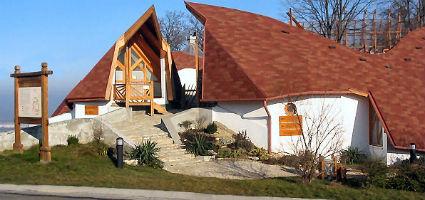2024. April 26. Friday
Saint James Benedictine Monastery Ruins - Kaposvár
 |
Address: 7400, Kaposvár Várdomb u. 1.
Phone number: (82) 314-915
E-mail: vaszary@dravanet.hu
Opening hours: Temporarily closed.
|
The ruins of the Abbey of Kaposszentjakab is located int he outskirts of Kaposvár, ont he brinks of Zselicség. The road passing by has been used from prehistoric times. Settlements in the region have been populated for 6000 years. There are also large Avar cemeteries from the 7-9th century in the region.
There only exist theories of the settling of the Magyar after 900 AD. Probably people belonging to Bogát-Bulcsú settled in most part of the county. The settlers were involved in the Árpád, later the Koppány reign around the middle of the 10th century. German knights who fought Koppány received land from King Stephen around then. These German knight guarded military and trade routs around Győr and Kaposvár.
The Győr family and the king both had manor houses around Kaposvár. The centre of the Győr family estate was established in the middle of he 11th century with the establishment of a cemetery and a Benedictine abbey was located close to Zselicszentjakab. According todoccuments, the son of Győr, the palatine Atha established the Benedictine monastery in 1601 'on the hill of Saint James, near the river Kapós'. This was the first definable manor in the territory of present Kaposvár.
The village existed all through the middle ages but never became a town. The old church was probably demolished during the revolt of non-believers in the first part of the 11th century. The remaining ruins were included in the new abbey built in 1067. The King Salamon and his son took part in the ordination.
The history of the abbey goes all the way, from the Árpád age through the reign of Mathias Rex and the Turkish reign. The last reconstruction of the building took place in 2001. The nice monastery is located at one of the nicest places of Kaposvár. It often holds cultural programs, one of these is the Szentjakap Summer Evenings Open-air Arts Festival. The ruins of the monastery built in 1061 are also the oldest protected building of the town.
We show nice stones from the Roman age and Gothic stones in the stone collection. Stones from Szenjakab can also be found in the stone collection of the National Gallery. After the ruin have been reconstructed, open-air theatre programs are held from 20 August 2001.
There only exist theories of the settling of the Magyar after 900 AD. Probably people belonging to Bogát-Bulcsú settled in most part of the county. The settlers were involved in the Árpád, later the Koppány reign around the middle of the 10th century. German knights who fought Koppány received land from King Stephen around then. These German knight guarded military and trade routs around Győr and Kaposvár.
The Győr family and the king both had manor houses around Kaposvár. The centre of the Győr family estate was established in the middle of he 11th century with the establishment of a cemetery and a Benedictine abbey was located close to Zselicszentjakab. According todoccuments, the son of Győr, the palatine Atha established the Benedictine monastery in 1601 'on the hill of Saint James, near the river Kapós'. This was the first definable manor in the territory of present Kaposvár.
The village existed all through the middle ages but never became a town. The old church was probably demolished during the revolt of non-believers in the first part of the 11th century. The remaining ruins were included in the new abbey built in 1067. The King Salamon and his son took part in the ordination.
The history of the abbey goes all the way, from the Árpád age through the reign of Mathias Rex and the Turkish reign. The last reconstruction of the building took place in 2001. The nice monastery is located at one of the nicest places of Kaposvár. It often holds cultural programs, one of these is the Szentjakap Summer Evenings Open-air Arts Festival. The ruins of the monastery built in 1061 are also the oldest protected building of the town.
We show nice stones from the Roman age and Gothic stones in the stone collection. Stones from Szenjakab can also be found in the stone collection of the National Gallery. After the ruin have been reconstructed, open-air theatre programs are held from 20 August 2001.